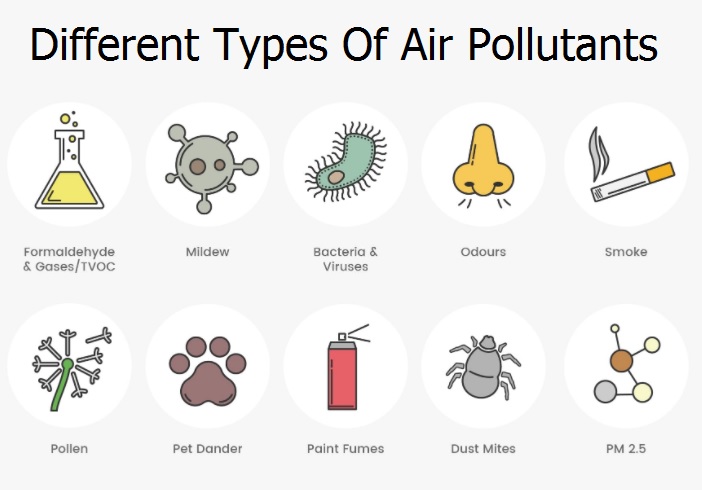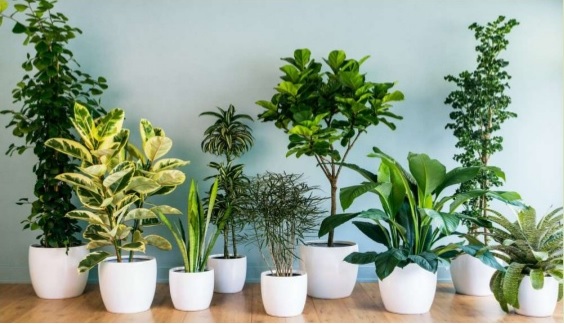Air purifiers and indoor plants are two common ways people choose to achieve clean air in their homes. Indoor air pollution is becoming an increasing problem and it is reported that indoor air is up to 5x more polluted than outdoor air. Therefore it is important you have at least some way to deal with this issue. There is a common debate of air purifier vs plants, as each has its own uses and it can sometimes be hard for people to decide which route to choose. So, which one is better for cleaner air – air purifier or plants?
Air purifiers are, in general, much better for air cleaning purposes than indoor plants. There are different types of air purifiers and the majority of them can remove more types of air pollutants from the air than plants can. Plants are only good at removing volatile organic compounds (VOCs) and toxins like formaldehyde, carbon monoxide, xylene, benzene etc. Plants can not remove particulate matter such as dust and pet dander, which many air purifiers can. In some cases, indoor plants and air purifiers work amazingly well together, as they can cover a wider range of air pollutants.
That being said, there are many benefits and downsides of using either one of these air cleaning options. Continue reading if you wish to learn more about the differences between air purifiers vs plans, and what each one of them does best.
Air purifiers vs plants – which types of air pollutants do they remove
Air pollutions is a very broad term. There are millions of harmful particles of all sizes in any polluted air and I could go on for days naming them all. Instead, it is much easier to divide them into smaller groups, which will help us a lot in future paragraphs. Here is a quick picture of the main types of air pollutants in our air.

Source: Probreeze.com
I have already mentioned that we also happen to have many different types of air purifiers. The different technologies used among these air purifier types determine which air pollutants they are effective against. Here are the 5 main categories of air purifiers that are currently on the market, along with a short description.
- HEPA filtration – uses HEPA filter technology to trap particles as small as 0.3 microns in size. Currently the most popular air purifier group on the market.
- UV light air purifiers – use different ultraviolet wavelengths to literally destroy air pollutants and disinfect surfaces.
- Carbon filtration – uses charcoal to trap gas molecules, and are often combined together with HEPA filters.
- Ionic air purifiers – use negative ions to neutralize even the smallest harmful particles in the air. Most air cleaning potential.
- Ozone generators – produce large amounts of ozone (O3) to clean and disinfect the air.
In short, we have 5 different air purifier types that use various technologies to achieve cleaner indoor air. Let us take a closer look at which pollutants each air purifier can remove, and compare it with plants.
Source: ionizerhub.com
As you can see, the results vary a lot. Some air purifier types are best at removing one type of air pollutants, while others are best at removing other types. This is part of the reason why many commercial air purifiers are actually a combination of a couple of different air cleaning technologies. By doing that, they can cover more air pollutant types, improving indoor air quality even further.
I am sure that you also noticed the word “possibly” under some combinations. Without going into too much detail, these air pollutants can or can not be removed by that specific air purifying technology – it depends on a few factors, such a the quality of parts. For example, HEPA filters have different tiers of effectiveness, which depends on how good the filter is. A standard HEPA filter can remove particles of 0.3 microns in size, while top tier HEPA filters can remove even smaller particles of up to 0.1 microns. Same technology, but different results.
Recommended plants for improved air quality
In terms of pollutant removal, indoor plants resemble air purifiers that use carbon filtration technology. Therefore plants specialize in the removal of volatile organic compounds, formaldehyde (which most purifier types struggle to remove), and in some cases even certain smells or odors. The most common harmful gasses/toxins found in homes are xylene, benzene, trichloroethylene, carbon monoxide, and of course formaldehyde.

Here is a list of some great plants for removing these different toxins:
Xylene: Devil’s Ivy, Dwarf Date Palm, Peace Lily, Spider Plant, Chrysanthemums, Rubber plants.
Benzene: Devil’s Ivy, Peace Lily, Chrysanthemums, Rubber plants, Snake Plant.
Trichloroethylene: Devil’s Ivy, Peace Lily, Rubber plants, Areca palms.
Formaldehyde: Devil’s Ivy, Dwarf Date Palm, Peace Lily, Spider Plant, Chrysanthemums, Rubber plants.
Carbon monoxide: Peace Lily, Areca palms.
There are many other viable options, but I chose to list the most popular/best ones that I know of.
The pros and cons of plants vs air purifiers
So far, we have looked at different air pollutants that indoor plants and air purifiers can effectively deal with. The next step to ask ourselves in this “plants or air purifiers” debate is, of course, the benefits and disadvantages of using both.
First I will be looking at plants. Here is a quick summary for the pros and cons of using plants for air purification, in relation to traditional air purifier machines:
While plants do have very limited air cleaning abilities, you should not take them lightly. They specialize in removing chemicals and toxins that many traditional air purifiers struggle to deal with. Pair that with other proven health benefits and you get a very inexpensive method of air purification. What plants can not do in term of air purification , they compensate for it in other areas. This makes them a very valuable tool to have in any home.
Next, let us take a look at traditional air purifier devices. Here are the pros & cons, in relation to plants – for air purification purposes.
While they do clean the air much better than indoor plants, this comes (understandably) with a higher price tag. But they also come with a lof of great features that make them a worthwhile investment. Quite a few of these are so small, yet powerful, that you can take them together with you when traveling – something that you just can not do with plants. Traditional air purifiers are also mostly hands-off when it comes to upkeep and maintenance. You turn them on, configure the setting, and let them do their thing. Every few months you change the filters and that is pretty much it.
I want to talk about ozone next. I have already written about air purifier ozone quite a lot in different posts, but I would like to add a word or two here. Some air purifiers, such as UV light and air ionizer can produce ozone, which is harmful for humans, animals, and plants alike. This is very important information to keep in mind when deciding about your next air purifier purchase, as you want to (ideally) pick one that produces no ozone, or close to no ozone.
To summarize this part, both plants and air purifiers have their own unique sets of benefits and disadvantages, which you need to take into account when deciding if air purifiers or plants are the best fit for you. Everyone has a different situation so not everyone will benefit the same from both.
So, air purifier or plants – which one should you get?
Sadly, there is no black and white answer that would be the default answer. In the perfect scenario, a combination of an air purifier and indoor plants would be ideal. It mostly comes down to what you are looking to get out of an air purifier, what is your current indoor air quality, and which problems are you facing. Answering these three questions will bring you closer to understanding which would suit you better in this air purifier vs plants dilemma.
In most cases, a traditional air purifier is the way to go. They have become so good and effective at increasing indoor air quality that it is hard to pass up on one. They do come with their own sets of challenges, but these can be avoided with relative ease. You can not solve common mold problems, allergies, pet dander, cigarette smoke, and similar with plants, but you can with air purifiers. And the best part? You do not need to break your bank to do so. Very good entry-level air purifiers can be found for as low as $50 – a small price to pay for what you get in return. Unfortunately, there are many bad budget-friendly air purifiers on the market that should be avoided. For this reason, I have prepared a list of the top 5 best air purifiers under $50. Check it out, if you are new to the market of air purifiers. If you want something a bit more powerful – then here is a list of top 5 best air purifiers under $150.
That being said, plants should not be underestimated because their ability to remove VOCs and toxins is not only great, but also proven. Plants are a really inexpensive way of getting into the air purifying world. They are always a great addition to any home and come with a lot of extra benefits – some of which I wrote under the pros & cons section. While they won’t offer you any protection from other types of air pollutants, they will brighten up your room, mood, improve humidity, and remove dangerous toxins & organic compounds from the air.
To conclude – consider your current situation, define your goals regarding air quality, and the budget you are willing to spend on better air quality. You will quickly be able to see if an air purifier or plants are the way to go. You can not go wrong by investing into either one of these, and you can always add more or upgrade at a later time. Go by your own pace and do what feels best for your situation. Your air will be cleaner in both situations.
